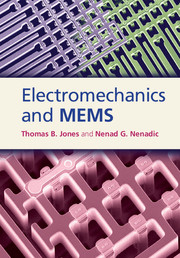Book contents
- Frontmatter
- Contents
- Preface
- 1 Introduction
- 2 Circuit-based modeling
- 3 Capacitive lumped parameter electromechanics
- 4 Small-signal capacitive electromechanical systems
- 5 Capacitive sensing and resonant drive circuits
- 6 Distributed 1-D and 2-D capacitive electromechanical structures
- 7 Practical MEMS devices
- 8 Electromechanics of piezoelectric elements
- 9 Electromechanics of magnetic MEMS devices
- Appendix A Review of quasistatic electromagnetics
- Appendix B Review of mechanical resonators
- Appendix C Micromachining
- Appendix D A brief review of solid mechanics
- Index
- References
4 - Small-signal capacitive electromechanical systems
Published online by Cambridge University Press: 05 May 2013
- Frontmatter
- Contents
- Preface
- 1 Introduction
- 2 Circuit-based modeling
- 3 Capacitive lumped parameter electromechanics
- 4 Small-signal capacitive electromechanical systems
- 5 Capacitive sensing and resonant drive circuits
- 6 Distributed 1-D and 2-D capacitive electromechanical structures
- 7 Practical MEMS devices
- 8 Electromechanics of piezoelectric elements
- 9 Electromechanics of magnetic MEMS devices
- Appendix A Review of quasistatic electromagnetics
- Appendix B Review of mechanical resonators
- Appendix C Micromachining
- Appendix D A brief review of solid mechanics
- Index
- References
Summary
Background
In this chapter, we introduce the linear electromechanical two-port, its multiport generalization, and equivalent circuit models for them. This MEMS representation makes it possible to invoke the so-called cascade design paradigm. The resulting electromechanical multiport networks and equivalent circuits broadly describe the critical behavior of microelectromechanical devices and systems. For the cascaded sensor depicted in Fig. 4.1a, the mechanical input might be a pressure perturbation acting on a diaphragm or an acceleration acting on a proof mass. In whatever form taken, this input acts on a mechanical element that possesses mass and is constrained by a restoring spring, mechanical damping, and possibly other influences. The electromechanical coupling converts this motion into an electrical signal, which is then appropriately conditioned and electronically amplified by a detector. For the actuator in Fig. 4.1b, an input electrical signal drives the electromechanical transducer, which in turn produces a force acting on the mechanical system. The system then responds with the desired motion. These schemes are typical examples of cascaded systems consisting of sequentially connected two-port networks.
The crucial assumption of the electromechanical two-port construct is that the amplitudes of the electrical and mechanical perturbations are small enough to justify linearization of the coupling mechanism. Linearization leads directly to transmission matrices similar to those introduced in Chapter 2. More importantly, the full power of linear systems theory, starting with AC phasors and transfer functions, becomes available. Initially, students with electrical engineering backgrounds will have the advantage because they are already adept at using these methods to design and analyze electronic amplifiers and filters.
Information
- Type
- Chapter
- Information
- Electromechanics and MEMS , pp. 97 - 149Publisher: Cambridge University PressPrint publication year: 2013
